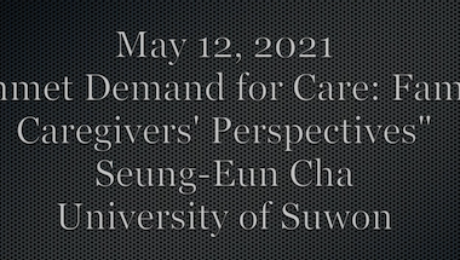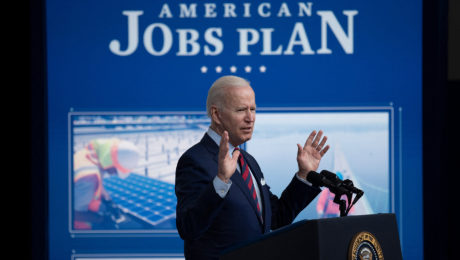Unmet Demand for Care: Family Caregiver’s Perspectives
Korea faces a care conundrum where the proportion of family care provision for children and the elderly has been consistently large even though the supply of paid care workers has increased over the years. During the first day of the Concluding Annual Meeting, Dr. Seung-Eun Cha, (University of Suwon) presented collaborative research with Eunhye Kang (Seoul National University), Dr. Maria Floro (American University), Shirin Arslan (American University), and Arnob Alam (American University), that questions whether there is an unmet demand for care in South Korea. It also questions whether such an unmet demand results from a preference for family care or because primary household caregivers are unable to utilize outside care resources despite wanting to do so.
The study contrasts the current number of hours primary household caregivers (usually, women – specifically daughters-in-law), spend on care activities with their preferred number of hours they would like to spend on care activities; the premise being that if there is a gap between the actual time and the preferred time, then, there must be an unmet demand for care services.
The study uses data from the 2018 Care Work-Family Survey on Childcare and Eldercare in South Korea and studies a sample of 1001 households. Results show that, on average, primary household caregivers spend about 26 and 20 hours more than they prefer each week on eldercare and childcare, respectively. Primary caregivers also reported the number of hours they would prefer their spouse to provide care. Results show that they prefer the spouse to engage in more care work, even if they are currently utilizing paid care services; specifically, around 3 and 7 hours more than they do currently on eldercare and childcare. Low-income groups have a relatively larger unmet demand for eldercare and childcare, while more educated mothers experience a more significant gap for childcare. Furthermore, households in rural areas also showed a larger unmet demand for childcare.
To watch the full presentation, see below.
Written by Praveena Bandara, Research Assistant for the Care Economy Project and PhD student in Economics at American University.
- Published in Child Care, Conferences, Expert Dialogues & Forums, Policy
Biden’s American Jobs Plan Could Be Monumental for the Care Economy in the U.S.
Last month, the Biden administration revealed the details of the $2 trillion American Jobs Plan.
The plan recognizes that investing in the care economy, as with investments in traditional infrastructure, can lift incomes, unleash productivity, and pave the path towards a more equitable economic recovery and growth.
Addressing the care crisis
Built into the plan is a pledge to “solidify the infrastructure of our care economy by creating jobs and raising wages and benefits for essential home care workers.” The plan calls for Congress to invest $400 billion towards expanding access to quality, affordable home- or community-based care for aging relatives and people with disabilities. These investments will help Americans to obtain the long-term services and support they need, while creating new jobs and offering care workers a long-overdue raise, stronger benefits, and an opportunity to organize or join a union and collectively bargain. Research has shown that increasing the pay of care workers leads to better quality care overall. Through creating well-paying care jobs with benefits and o collectively bargaining rights, as well as building state infrastructure, the plan aims to improve both the quality of job for care workers and the quality of service for care recipients.
Lack of access to childcare makes it harder for parents, especially mothers, to fully participate in the workforce, hurting families and hindering U.S. growth and competitiveness. In areas with the greatest shortage of child care slots, women’s labor force participation is about three percentage points less than in areas with a high capacity of child care slots. The pandemic has severely exacerbated this problem with more than 1 in 4 facilities still remaining closed as of December 2020. President Biden is calling on Congress to provide $25 billion to help upgrade child care facilities and increase the supply of child care in areas that need it most. These funds are to be provided through a Child Care Growth and Innovation Fund for states to build a supply of infant and toddler care in high-need areas. Also included in this $25 billion is a call for expanded tax credits to incentivize businesses to provide care facilities at their establishments. This will grant accessible, high quality care and learning environments for children of employees. This particular part of the plan is structured so that employers will receive 50 percent of the first $1 million of construction costs per facility.
Investment in care is investment in infrastructure
As Cecelia Rouse, Chair of the Economic Advisors for the Biden administration, recently indicated during a recent press conference, we need to “upgrade our definition of infrastructure” to include the care economy. Rouse defended the Biden administration’s plan to spend $400 billion of the infrastructure plan’s budget on the care economy, defining it as a legitimate infrastructure investment and a key component to addressing economic inequities in the U.S. The care economy is critical to U.S. economic activity, and its absence would greatly hinder economic productivity. The inclusion of care work and the care economy in the American Jobs Plan is a critical first step in mending a critically broken care infrastructure in the U.S.
Still, it is only the first step. The U.S. is the only industrialized nation that fails to provide national paid family leave and medical leave programs, and where hundreds of thousand sit on waiting lists for desperately needed home care. LeadingAge, which represents service providers in the sector, estimates that half of all Americans will need long-term services and support after turning 65, and that by 2040, a quarter of the U.S. population will be 65 or older. In addition to the President’s proposal for the care economy, we also need investments to finally put America on a path to universal childcare and early learning, national paid family and medical leave and paid sick days for all workers. The COVID-19 pandemic has exposed both the importance of care work and the vulnerabilities of our care infrastructure. At the same time, it has also created an opportunity for us to rethink the value of care and care work, opening ways for us to rebuild a more resilient care infrastructure and a more inclusive economy.
This blog was authored by Jenn Brown, CWE-GAM Communications Assistant
- Published in Child Care, Economic Recovery, Policy, U.S.


